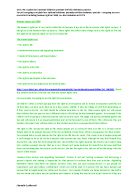Unit 2 task 1 - examples of discriminatory practise
Discriminatory practice:
Infringement of rights: Infringing a service users rights means treating them in an unfair, unequal or legal way. These could be physical, for example restraining a patient for no logical reason; Financial, for example not informing them that they are entitled to disability benefits or other government benefits; psychological, for example making them feel like they are worthless or not as valued as other service users. It is the care workers’ responsibility to ensure servo=ice users do not have their rights infringed.
The various types of abuse: Abuse is when someone is taken advantage of in a negative way. It can be overt or covert, and there are various types of abuse. For example it can be physical, for example punching, kicking, restraining someone unnecessarily, or handling people roughly when helping them with bathing, moving or using the toilet; sexual, for example doing things to a person without their consent; psychological, for example humiliating someone or harassing them; financial, for example stealing their money or possessions, or putting pressure on someone to give you money. Those most at risk from danger and harm are children, individuals with mental health problems, individuals with learning disabilities or physical disabilities, the elderly etc., as these kinds of people can be less powerful and easily influenced. Care workers can protect individuals from danger and harm by raising awareness of possible abuse or problems, monitoring who they have contact with, physically or written (e.g. who phones them, who they write to, who cares for them etc.), by training staff so they know what procedures to follow when they feel someone’s safety might be at risk etc.








